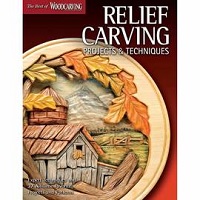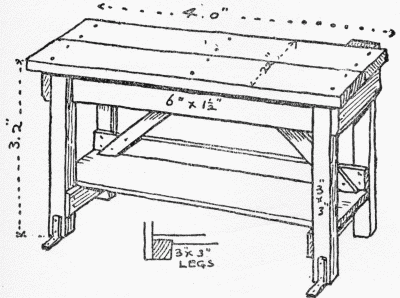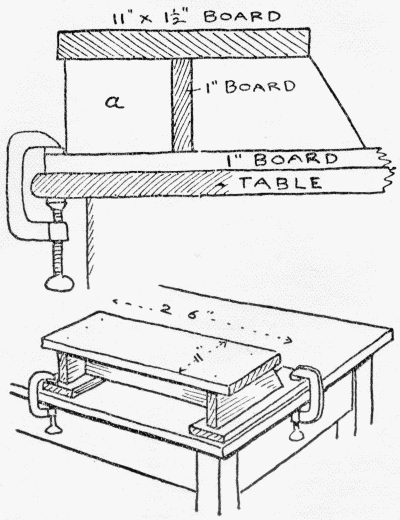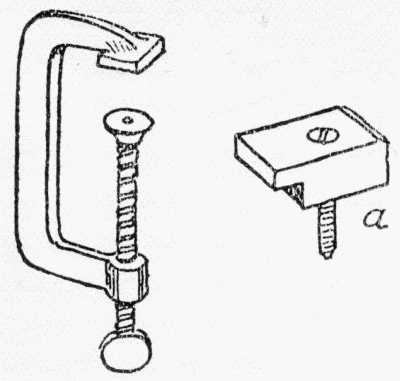Wood Carving
CHAPTER III
SHARPENING-STONES—MALLET AND BENCH
Different Stones in use—Case for Stones—Slips—Round Mallet Best—A Home-Made Bench—A Makeshift Bench—Cramps and Clips.

CLICK HERE CLICK HERE
The stones which are most generally used for the purpose of sharpening carving tools are "Turkey" and "Washita." There are many others, some equally good, but "Washita" is easily procured and very serviceable. It is to be had in various grades, and it may be just as well to have one coarse and one fine, but in any case we must have a fine-grained stone to put a keen edge on the tools.
A "Turkey" stone is a fine-grained and slow-cutting one, and may take the place of the finer "Washita." The "India" oilstone is a composition of emery with some kind of stone dust, and [43] is a useful stone for quickly rubbing down superfluous steel before putting an edge to the tool.It is better to get these stones without cases, as they can then be used on both sides, one for flat tools and one for gouges, which wear the face of a stone into grooves. A case may be made by hollowing out a block of wood so as to take the stone loosely; and if at one end a small notch is made in this block, a screwdriver may be inserted under the stone when it is necessary to turn it. Two brads or pins should be inserted in holes, having their points just appearing below the bottom of the block. These prevent it slipping about when in use. These stones should be lubricated with a mixture of olive oil and paraffin in equal parts. Bicycle lubricating oil is very good for this purpose.
For sharpening the insides of tools, "slips" are made with rounded edges of different sizes. One slip of "Washita" [44] stone and one of "Arkansas" will be enough for the present, as they will fit moderately well most of the gouges in the beginner's set of tools; the "Arkansas" being used for the smaller tools. The "Arkansas" slip should be what is called "knife-edged." This is required for sharpening such tools as the veiner and V tool; it is a very fine marble-like stone, and exceedingly brittle; care must be taken in handling it, as a fall would in all probability be fatal.
THE BENCH AND MALLET
The Mallet.—The carver's mallet is used for driving his tools where force is required. The most suitable form is the round one, made of beech; one 4 ins. diameter will be heavy enough.
The Bench.—Every carver should provide himself with a bench. He may make one for himself according to the size and construction shown in the illustration, Fig. 5. The top should be made of two 11 x 2 in. boards, and, as steadiness is the main feature to be aimed at, the joints should have some care. Those in illustration are shown to be formed by checking [45] one piece of wood over the other, with shoulders to resist lateral strain. Proper tenons would be better, but more difficult to make. It must have a projecting edge at the front and ends, to receive the clamps. The bench should have a joiner's "bench-screw" attached to the back leg for holding work which is to be carved on its edges or ends. The feet should be secured to the floor by means of iron brackets, as considerable force is applied in carving hard wood, which may move the bench bodily, unless it is secured, or is very heavy. Professional carvers use a bench [46] which is composed of beech planks, three or four inches in thickness, and of length according to shop-room.
Should it not be possible to make or procure a bench, then a substitute must be used. Fig. 6 gives a suggestion for [47] making such a temporary bench. The top is composed of one piece of board, 11 ins. wide and 1-1/2 in. thick. It should be about 2 ft. 6 ins. long and rest on two blocks fixed about 1-1/2 in. from the ends, which must project, as in Fig. 6. This may be used on any ordinary table, to which it should be secured by means of two 3-1/2-in. clamps. The height from the floor should be 3 ft. 2 ins. to top of board. This gives a good height for working, as carvers invariably stand to their work. The height can be regulated by making the blocks, a, higher or lower to suit the table which is to be used.
Cramps.—Cramps for holding the work in position on the bench are of several kinds. For ordinary thicknesses of wood, two 4-1/2-in. screw clamps, like the one in Fig. 7, will be sufficient. Wooden blocks may be also used to hold one end of the work down while the other is held by a clamp. These blocks [48] are notched out to fit over the thickness of the board being carved, as in Fig. 7. Carvers use for their heavier work a "bench-screw," as it is called; that is, a screw which passes through the bench into the back of the work, which may thus be turned about at will; also, if the work is very thick, they hold it in position by means of a bench "holdfast," a kind of combined lever and screw; but neither of these contrivances is likely to be required by the beginner, whose work should be kept within manageable dimensions.





